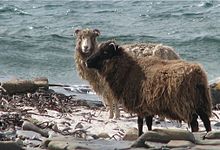 Two sheep on the shoreline of North Ronaldsay | |
| Conservation status | |
|---|---|
| Country of origin | Scotland |
| Use | meat, wool |
| Traits | |
| Weight |
|
| Height |
|
| Wool colour | white, grey, brown, black |
| Horn status | horned |
| |
The North Ronaldsay or Orkney is a breed of sheep from North Ronaldsay, the northernmost island of Orkney, off the north coast of Scotland. It belongs to the Northern European short-tailed sheep group of breeds, and has evolved without much cross-breeding with modern breeds. It is a smaller sheep than most, with the rams (males) horned and ewes (females) mostly hornless. It was formerly kept primarily for wool, but now the two largest flocks are feral, one on North Ronaldsay and another on the Orkney island of Auskerry. The Rare Breeds Survival Trust lists the breed as a priority on its 2021–2022 watchlist, and they are in danger of extinction, with fewer than 600 registered breeding females in the United Kingdom.
The semi-feral flock on North Ronaldsay is the original flock that evolved to subsist almost entirely on seaweed – they are one of few mammals to do this. They are confined to the foreshore by a 1.8 m (6 ft) early 19th century drystane dyke, which completely encircles the island, forcing the sheep to evolve this unusual characteristic. The wall was built as kelping (the production of soda ash from seaweed) on the shore became uneconomical. Sheep were confined to the shore to protect the fields and crofts inside, and afterwards subsisted largely on seaweed.
This diet has caused a variety of adaptations in the sheep's digestive system. These sheep have to extract the trace element copper far more efficiently than other breeds as their diet has a limited supply of copper. This results in them being susceptible to copper toxicity, if fed on a grass diet, as copper is toxic to sheep in high quantities. Grazing habits have also changed to suit the sheep's environment. To reduce the chance of being stranded by an incoming tide, they graze at low tide and then ruminate at high tide.
A range of fleece colours are exhibited, including grey, brown and red. Meat from the North Ronaldsay has a distinctive flavour, described as "intense" and "gamey",[3] possibly in part due to the high iodine content in their diet of seaweed.
- ^ Barbara Rischkowsky, D. Pilling (eds.) (2007). p. 138. List of breeds documented in the Global Databank for Animal Genetic Resources, annex to The State of the World's Animal Genetic Resources for Food and Agriculture. Rome: Food and Agriculture Organization of the United Nations. ISBN 9789251057629. Accessed August 2017.
- ^ "Watchlist 2017–18". Stoneleigh Park, Warwickshire: Rare Breeds Survival Trust. Retrieved 30 April 2022.
- ^ Cite error: The named reference
Hollwegwas invoked but never defined (see the help page).